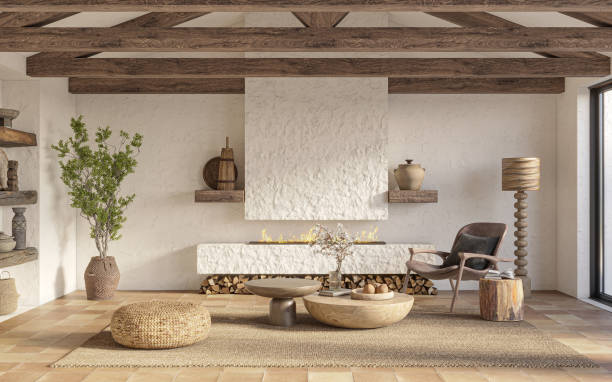The Whimsical World of Wabi-Sabi Interiors
In a world obsessed with perfection, a unique design philosophy is quietly making waves in American homes. Wabi-sabi, an ancient Japanese aesthetic that embraces imperfection and transience, is finding its place in modern interior design. This concept, once confined to traditional Japanese tea houses, is now transforming living spaces across the United States into havens of serenity and authenticity.

The Roots of Wabi-Sabi
Wabi-sabi finds its origins in 16th century Japanese tea ceremonies. The term combines two concepts: wabi, which refers to the beauty of simplicity and humility, and sabi, which embraces the passage of time and the beauty of aging. Together, they form a worldview that appreciates the imperfect, impermanent, and incomplete nature of all things.
In traditional Japanese culture, wabi-sabi manifested in rustic tea houses, asymmetrical pottery, and the appreciation of natural patinas. It was a counterpoint to the ornate and ostentatious, favoring instead the subtle, the humble, and the authentic.
Wabi-Sabi in Modern American Homes
The transition of wabi-sabi from ancient Japanese philosophy to contemporary American interiors is a testament to its timeless appeal. In today’s fast-paced, technology-driven world, the principles of wabi-sabi offer a much-needed antidote to the pursuit of perfection.
In American homes, wabi-sabi interiors are characterized by natural materials, earthy color palettes, and handcrafted elements. Rough-hewn wooden beams, unfinished concrete floors, and hand-thrown pottery are common features. The goal is not to create a replica of a Japanese tea house, but rather to infuse spaces with a sense of calm, authenticity, and connection to nature.
Key Elements of Wabi-Sabi Design
To incorporate wabi-sabi into your home, consider the following elements:
- Natural Materials: Opt for raw, unfinished materials like wood, stone, and clay. Look for pieces that show their age and imperfections.
- Neutral Color Palette: Embrace earthy tones and muted colors inspired by nature. Think warm greys, soft whites, and rich browns.
- Handcrafted Items: Incorporate handmade ceramics, textiles, and furniture. The slight irregularities in these pieces add character and charm.
- Minimalism: Declutter your space and focus on a few meaningful items rather than an abundance of decorations.
- Organic Forms: Choose furniture and decor with irregular shapes and asymmetrical designs to reflect the imperfect beauty of nature.
The Psychology of Wabi-Sabi Spaces
The appeal of wabi-sabi interiors goes beyond aesthetics. Research in environmental psychology suggests that spaces designed with wabi-sabi principles can have significant positive effects on mental well-being.
The emphasis on natural materials and textures can help reduce stress and promote a sense of calm. The acceptance of imperfection in wabi-sabi spaces can also alleviate the pressure many feel to maintain a perfectly curated home, leading to increased relaxation and contentment.
Moreover, the focus on simplicity and minimalism in wabi-sabi design can help combat the overwhelming nature of modern life, providing a sanctuary from digital overload and consumerism.
Wabi-Sabi and Sustainability
One of the most compelling aspects of wabi-sabi design for modern homeowners is its inherent sustainability. The philosophy’s emphasis on appreciating aged and imperfect items naturally lends itself to upcycling, repurposing, and choosing quality over quantity.
In a wabi-sabi inspired home, furniture and decor are chosen for their longevity and ability to age gracefully. This approach stands in stark contrast to the throwaway culture often associated with fast furniture and trendy decor items.
By embracing wabi-sabi, homeowners can create spaces that not only look beautiful but also contribute to a more sustainable lifestyle. This alignment with eco-conscious values is particularly appealing to millennials and Gen Z, who are increasingly prioritizing sustainability in their purchasing decisions.
Challenges and Misconceptions
While wabi-sabi interiors are gaining popularity, they are not without challenges. One common misconception is that wabi-sabi means simply neglecting your space or filling it with worn-out items. In reality, achieving a true wabi-sabi aesthetic requires thoughtful curation and an understanding of the philosophy’s deeper principles.
Another challenge lies in balancing wabi-sabi elements with modern necessities. How does one incorporate technology or sleek appliances into a wabi-sabi inspired kitchen, for example? The key is to approach these integrations mindfully, perhaps hiding technology when not in use or choosing appliances with simple, unobtrusive designs.
The Future of Wabi-Sabi in American Design
As we look to the future, the principles of wabi-sabi are likely to become even more relevant in American interior design. In a post-pandemic world where many have reassessed their relationships with their homes, the calm and authenticity of wabi-sabi spaces hold immense appeal.
We may see a rise in wabi-sabi inspired products, from furniture lines that celebrate natural imperfections to decor items that age beautifully over time. There’s also potential for wabi-sabi principles to influence architecture, with a greater emphasis on natural materials and designs that work in harmony with the surrounding environment.
Embracing Imperfection in Your Home
Incorporating wabi-sabi into your home doesn’t require a complete overhaul. Start small by bringing in natural elements like driftwood or river stones, or by displaying a cherished item that shows signs of wear. Embrace the patina on your wooden furniture rather than refinishing it, or choose a handmade ceramic vase over a mass-produced one.
Remember, the goal of wabi-sabi is not to create a perfectly styled space, but to cultivate an environment that feels authentic, serene, and deeply connected to the natural world. It’s about finding beauty in the imperfect, incomplete, and impermanent - a powerful antidote to the polished perfection often portrayed in design magazines and social media.
As we navigate an increasingly digital and fast-paced world, the timeless wisdom of wabi-sabi offers a path to create homes that are not just visually appealing, but restorative sanctuaries that nourish the soul. By embracing this ancient philosophy, we can transform our living spaces into havens of tranquility, authenticity, and mindful living - a true luxury in today’s world.





